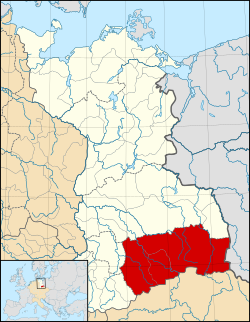Margraviate of Meissen
| Margravate of Meissen | ||||||||||
| Markgrafschaft Meißen | ||||||||||
| State of the Holy Roman Empire | ||||||||||
|
||||||||||
|
||||||||||
|
The March of Meissen (red) around the start of the 11th century.
|
||||||||||
| Capital | Meissen | |||||||||
| Languages | Upper Saxon | |||||||||
| Government | Feudal monarchy | |||||||||
| Margrave of Meissen | ||||||||||
| • | 965-985 | Rikdag of Harzgau (first) | ||||||||
| • | 1089-1103 | Henry I | ||||||||
| Historical era | Middle Ages | |||||||||
| • | Partitioned from Marca Geronis | 965 | ||||||||
| • | Investiture Controversy¹ | 1067 | ||||||||
| • | War of Thuringian Succession | 1247–64 |
||||||||
| • | Acquired most of Thuringia | 1298 |
||||||||
| • | Battle of Lucka | 1307 | ||||||||
| • | Frederick IV assigned Saxe-Wittenberg | 1423 | ||||||||
| • | Acquired Burggravate | 1426 | ||||||||
|
||||||||||
| 1: As a result of the Investiture Controversy in 1067, the territory was lost from the Brunonen to the Wettin dynasty. | ||||||||||
The Margravate of Meissen (German: Markgrafschaft Meißen), sometimes known as the March of Miśnia, was a medieval principality in the area of the modern German state of Saxony. It originally was a frontier march of the Holy Roman Empire, created out of the vast Marca Geronis in 965. The margravate was finally merged into the Saxon Electorate in 1423.
The Margravate of Meissen was originally part of a march called the Sorbian march, which was later renamed to the Thuringian March. Thuringia was the name of the land east of the Saale, a land inhabited by Polabian Slavs. The eastern part of the Thuringian March around the fortress near the Dresden Basin became the Margravate of Meissen.
In 928 and 929, during a campaign against Slavic Glomacze tribes, the German king Henry the Fowler had a fortress built on a hill next to the Elbe River called Albrechtsburg. The fortress was later renamed Meissen after the nearby Meisa stream.
A town soon developed around the castle. Henry, however, made no attempts to Germanise the Slavs or to create a chain of burgwards around his fortress. Meissen sat alone, like Brandenburg, with few defenses or towns around it. The town around the fortress grew however, eventually becoming one of the most important cities in the large Marca Geronis region, which included the lands east of the German stem duchy of Saxony.
King Henry, and later on his son King Otto I, continued the Slavic campaigns into the lands of the Polabian Milceni tribes around Bautzen, with their gained territory being gradually incorporated into the Saxon eastern march. When the marca was divided in 965 upon the death of Margrave Gero, Meissen became the center of a new march with the goal of controlling the local Sorbian population. The first Meissen Margrave, Wigbert, is mentioned in the 968 charter of the Archbishopric of Magdeburg. That same year, the Meissen fortress also became the see of the newly created Bishopric of Meissen. In 978, the Saxon count Rikdag became the Margrave of Meissen, and incorporated the marches of Merseburg and Zeitz into Meissen. By 982, the territory of the march had extended as far as the Neisse and Kwisa (Queis) rivers to the east and as far as the slopes of the Ore Mountains to the south, where it shared a border with the Přemyslid duchy of Bohemia.
...
Wikipedia




